Night of the Open Door
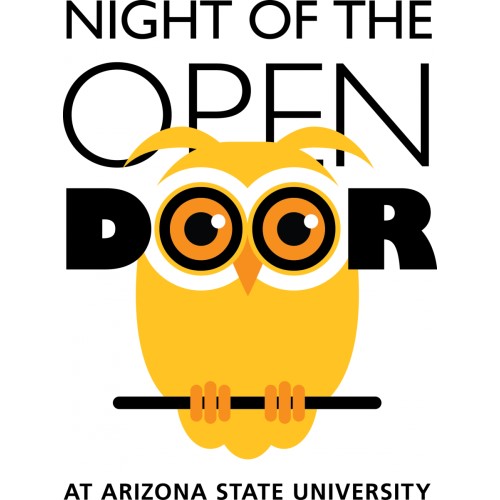
Night of the Open Door at Arizona State University (ASU) is an annual event that allows the general public to visit any of the five ASU campuses and get an inside peek to what ASU students see, do, and learn everyday. There are hundreds of interactive activities that visitors can participate in and thousands of students, faculty, and staff to teach them anything from science to technology to engineering to arts to math. Learn more about it here. During Night of the Open Door, I was at the BioDesign Institute, where visitors could learn about things from viruses to whale poop. I co-organized the activities put on by The Cartwright Lab. There were four main stations: Protein Puzzle, Disease Detectives, Seq N Destroy, and Next Gen Sequencing.
The Activities
The first thing visitors did when they came to the Disease Detectives activity was to grab their “Disease Detective Notebook” that lead them through the activity. They then went to the different posters of the diseases, cystic fibrosis, myostatin, and lactose intolerance, answered a few questions on the diseases by filling in the blank, and looked at the difference between the wild type and mutant sequence.
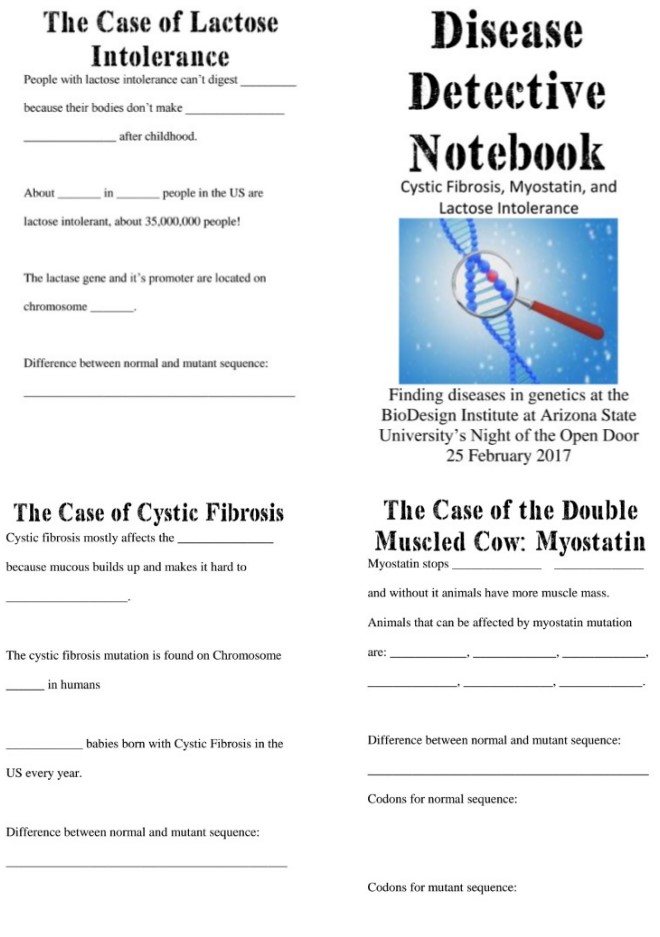
The cystic fibrosis mutation had a deletion of three nucleotides. The myostatin mutation had a deletion of eleven nucleotides. The lactose intolerance had a point mutation from C to T. The sequences on the posters were printed extremely small so that visitors would have to use a magnifying glass at the table to see them, reinforcing the idea of being detectives.

After completing the notebook, they were given a certificate stating they completed the Disease Detectives training program. The purpose of the Disease Detectives activity was to find and understand mutations and how they can cause diseases and different, often radical, phenotypes.
The Seq N Destroy was a computer came that was like a combination of tetris and bubble shooter where you try to stop reverse transcription of HIV. A player tries to shoot a nucleotide analog at the replicating strand. Once the nucleotide analog is incorporated, replication is stopped and the line is removed. One tries to clear the screen of lines of replicating HIV to be “cured.” The nucleotide analog that is shot into the replicating strand could be changed to any of the four base pairs. To play and understand the game, one has to have the knowledge that adenine pairs with thymine and cytosine pairs with guanine. This was integrated into the game design by having different colors and interlocking shapes for each nucleotide. The nucleotide analog was different from the normal nucleotides by making it a different color. Seq N Destroy can be accessed here. The purpose of the Seq N Destroy game was for visitors to understand how HIV is treated.
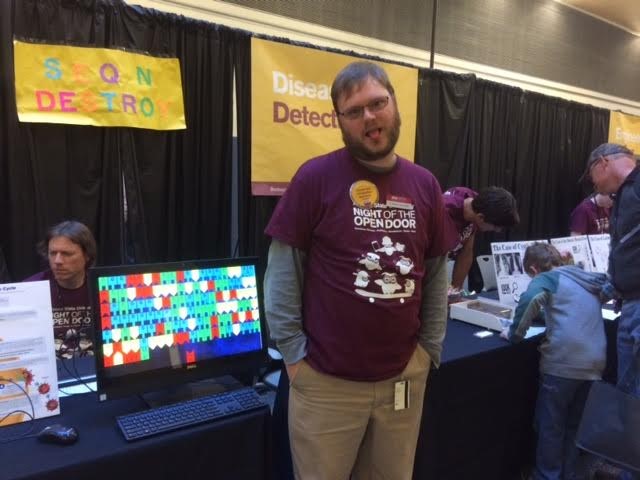
The Protein Puzzle was magnetic nucleotides that fit together in their respective pairs and amino acids on a whiteboard. There was a short sequence to represent mRNA and other nucleotides to represent the tRNA with their corresponding amino acids. The visitors could manipulate the mRNA sequence, tRNA, and amino acids to understand how different mutations affect the primary structure of a protein. Some mutations that could be visualized were silent mutations, point mutations, frameshift mutations, missense mutations, or nonsense mutations.
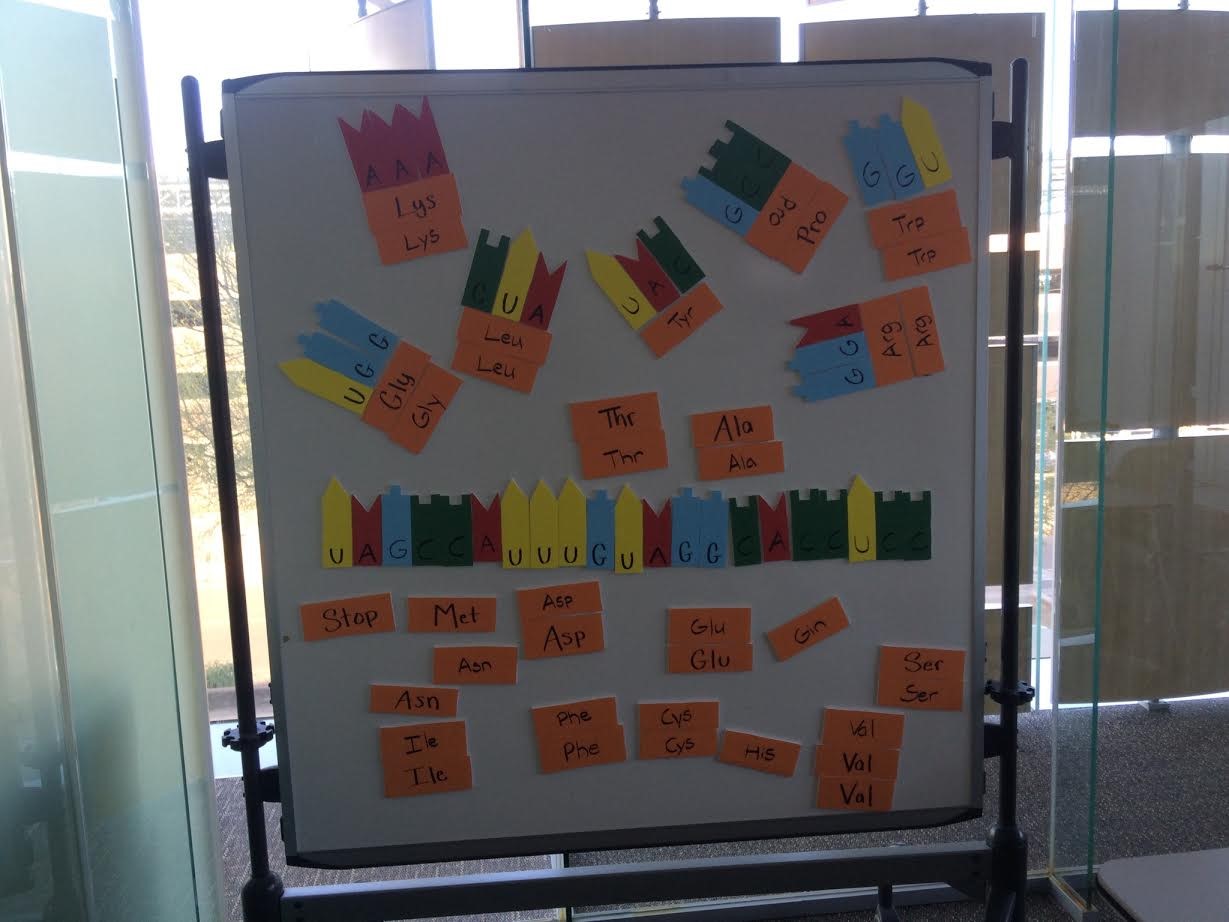
The Next Gen Sequencing was an activity where a visitor learned about how DNA sequences are read and recorded. A volunteer would demonstrate using the DNA strands and individual nucleotides to explain the activity. They would start by explaining that DNA is double stranded and each strand is the mirror image of the other. But only short strands can be read at one time. To get around this, one strand is read and recorded by attaching both DNA strand ends to a flow cell which makes a structure like a bridge. Then they separate the two strands using chemicals and wash away one strand. To read the DNA, we throw out a bunch of nucleotides one letter at a time and see which one sticks to our piece of DNA. Nucleotide binding to the DNA has to go in order starting at the top. Because A only binds to T and G only binds to C, we can tell when a nucleotide binds to another one because it will light up. We can then record the color light it makes to know which letter is next in our sequence. To read the rest of the strand, a copy of the DNA strand is made which makes another bridge that is separated again. This time they wash away the strand that has already been read. Then they use the light up nucleotides to read the remaining strand. The whole strand can be read when you line up each sequence and find where they overlap.
Activities Effectiveness and Proposed Future Changes
People stopped at different stations of the activity because they were curious. The kids and teens liked to stop at the Seq N Destroy game because it looked fun and was something that appealed to them. The game was easy to play and only took a few moments to understand how to win. Seq N Destroy was a great hook for people to come up to the activity. Once they were engaged in the game, a volunteer could explain the biology behind the game and how this technique is used to treat HIV infection. The hands-on visualization helped visitors grasp the concept, which can be complex and hard to understand without background knowledge. This provided a platform to explain the basics of DNA, nucleotides, HIV infection, replication, and base pairing if someone didn’t know them or go deeper in explanations with visitors who did. Something that the Seq N Destroy game could improve upon is gameplay. Adding instructions when you first open the game, side notes that pop up and explain a little bit about the biology behind the game, and adding a leaderboard are some things that could be enhanced. The creators in our lab plan to continue to add these features and more to the game for a better gameplay experience.
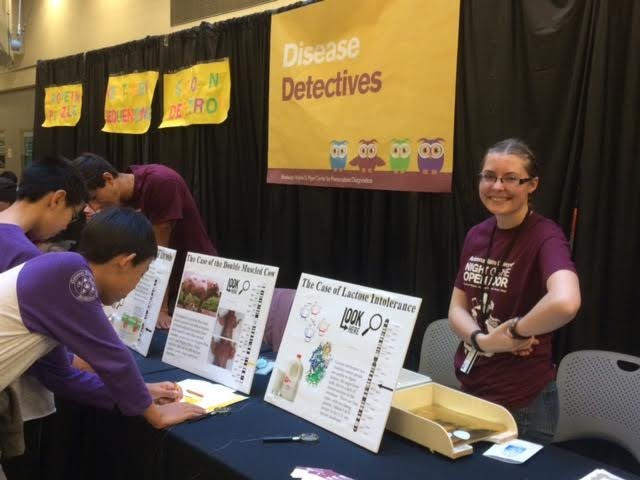
Visitors of all ages stopped at the Disease Detectives station. Kids ranging in ages from about 6-13 were happy to pick up the Disease Detectives Notebook and work on filling it out, eager to earn a certificate. Younger kids liked to pick up the magnifying glass and look through it at different things, such as the pictures on the posters. If they understood, a parent or volunteer could direct them to look at the sequences. Older teens and adults stopped because they wanted to know more about lactose intolerance because they or someone they knew were lactose intolerant, or they stopped because they wanted to know more about the Belgian Blue cows because of their incredible muscle mass. Teens and adults could step up and ask a volunteer about a poster and receive an answer without having to to fill out the notebook. Visitors of all ages were able to expand their knowledge of biology. One thing to change if this activity is to be repeated is the notebooks. They were a great idea to include the detective elements and to teach kids that scientists write down all of their observations. However, about halfway through filling out the notebook, kids became disinterested because it takes time to fill out. The notebooks were also like a homework assignment rather than a fun activity. Instead of having them fill in the blanks about the disease, only having them write down the difference in the wild type and mutant sequence would be a much better approach. It was also difficult for some kids to tell the differences between the wild type and mutant sequences. It would be better if dashes were added where there was a deletion in the mutant sequence. This would make it more clear what happened in the mutation.
Very few people stopped by the Protein Puzzle station. It takes a lot of explaining to understand and do the activity. Visitors don’t really want to stand there that long when they could go look at or do something else a little more interesting. It would be more effective for audiences that have a dedicated amount of time at a station instead of people coming and going. It was a great idea to have people learn, it just needs to be applied to a different setting. The Next Gen Sequencing had the same obstacle of lots of explanation. The station was also on the back of the white board that the Protein Puzzle was on and it eventually got turned so no one could see or know it was there.
Overall, the activity was a success. Visitors came and learned about DNA and how small changes can have big impacts on phenotype and that there are ways to treat HIV and had an enjoyable time doing it. There are minor changes to be made to the activity that would make it a better learning experience in the future.
This series is supported by NSF Grant #DBI-1356548 to RA Cartwright.
